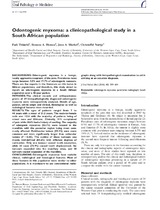| dc.contributor.author | Titinchi, Fadi | |
| dc.contributor.author | Hassan, Bassam A. | |
| dc.contributor.author | Morkel, Jean A. | |
| dc.contributor.author | Nortje, Christoffel | |
| dc.date.accessioned | 2017-04-13T13:35:29Z | |
| dc.date.available | 2017-04-13T13:35:29Z | |
| dc.date.issued | 2016 | |
| dc.identifier.citation | Titinchi,F. et al. (2016). Odontogenic myxoma: a clinicopathological study in a South African population. Journal of Oral Pathology and Medicine, 45: 599-604 | en_US |
| dc.identifier.issn | 904-2512 | |
| dc.identifier.uri | http://hdl.handle.net/10566/2739 | |
| dc.identifier.uri | http://dx.doi.org/10.1111/jop.12421 | |
| dc.description.abstract | Background: Odontogenic myxoma is a benign, locally aggressive neoplasm of the jaws. Prevalence rates range between 0.5% and 17.7% of odontogenic tumours. There are few reports in the literature on this lesion in African populations, and therefore, this study aimed to report on odontogenic myxoma in a South African population over a 40-year period. Methods: The clinical records and orthopantomograms of 29 histopathologically diagnosed odontogenic myxoma were retrospectively analysed. Details of age, gender, ethnic origin and clinical, histological as well as radiological features were recorded. Results: The ages of patients ranged from 7 to 44 years with a mean of 21.3 years. The male-to-female ratio was 1:2.6 with the majority of patients being of mixed race and Africans. Clinically, 31% complained of pain while 58.6% had a history of swelling. The majority of odongenic myxomas (62.1%) were located in the mandible with the posterior region being most commonly affected. Multilocular lesions (69.2%) were more common and were significantly larger than unilocular lesions (P < 0.05). The outline of these tumours was mostly well-defined (84.6%) with different degrees of cortication. Only one tumour caused tooth resorption, while 20 cases (76.9%) caused tooth displacement. Six tumours expanded into the maxillary sinus, and 14 tumours caused expansion of the mandible. Conclusions: Odontogenic myxomas have variable clinical, radiological and histological features. Most of these features in this population were similar to other populations. It is mandatory to use conventional radiographs along with histopathological examination to aid in arriving at an accurate diagnosis. | en_US |
| dc.language.iso | en | en_US |
| dc.publisher | Blackwell | |
| dc.rights | All the contents of this journal, except where otherwise noted, is licensed under a Creative Commons Attribution License | |
| dc.subject | Odontogenic myxoma | en_US |
| dc.subject | Panoramic radiograph | en_US |
| dc.subject | South Africa | en_US |
| dc.title | Odontogenic myxoma: a clinicopathological study in a South African population | en_US |
| dc.type | Article | en_US |
| dc.description.accreditation | ISI | |

